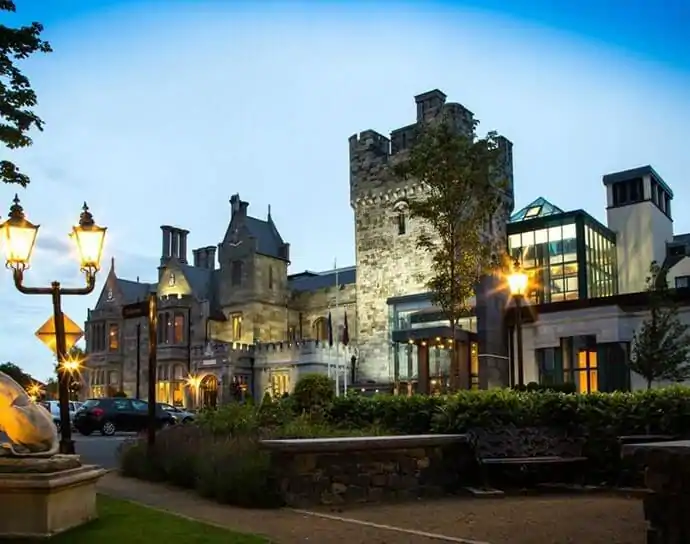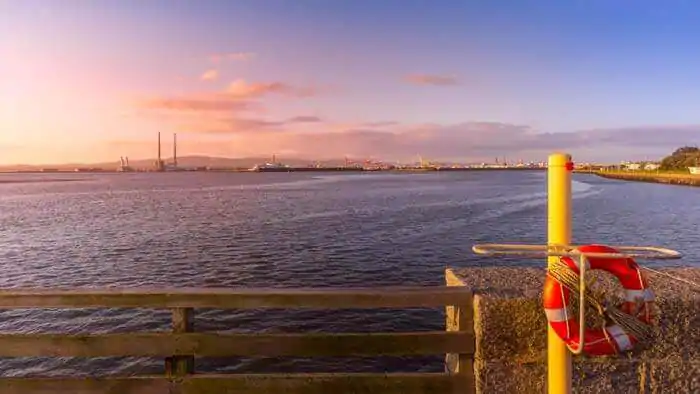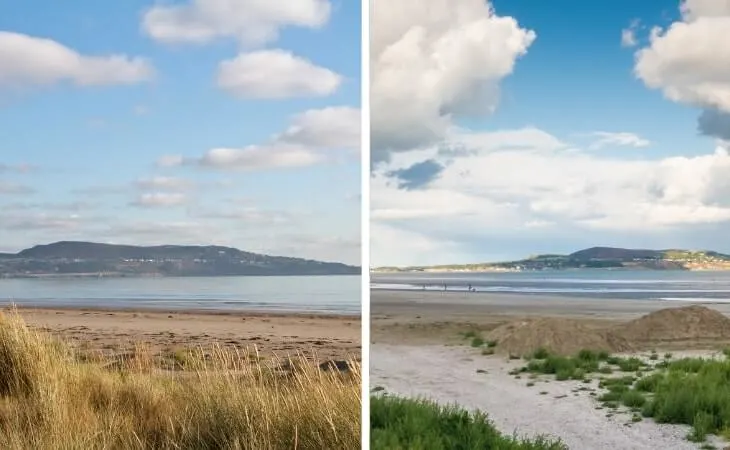Although there are several castle hotels in Dublin, few can go toe-to-toe with the stunning Clontarf Castle Hotel.
To the northeast of Dublin city centre lies the sea-front suburb of Clontarf, famous for the 1014 Battle of Clontarf, Dollymount Strand, Bull Island and, of course, Clontarf Castle.
Born of from an epic historic struggle, Clontarf Castle is now a boutique hotel with many of Dublin’s top attractions on its doorstep.
Some quick need-to-knows before you visit Clontarf Castle Hotel

Although a visit to Clontarf Castle Hotel is fairly straightforward, there are a few need-to-knows that’ll make your visit that bit more enjoyable.
Note: if you book a stay through one of the links below we may make a tiny commission that helps us keep this site going. You won’t pay extra, but we really do appreciate it.
1. Location
Clontarf and its castle are steeped in history. The castle has been home to some notable names, and when your foundations date back to the 1100s, there’s bound to be a story or two to discover.
2. It’s now a hotel
It’s only in more recent years that Clontarf Castle has become a luxury hotel. With the doors opening in June of 1997, it now boasts 111 4-star rooms. Guests can enjoy the romantic setting of vine-covered stonewalls and turreted towers, in-house dining at its bar, restaurant, or lounge.
3. A whole lot of history
Incredibly, there has been a castle on this site for centuries, with the very first Clontarf Castle dating to 1172. The first foundations for Clontarf Castle were laid in the late 1100s, and the castle has seen many renovations and restorations since.
4. A quirky, cosy place to stay
Clontarf Castle, like each of the castle hotels in Ireland, offers its guests some unique opportunities during their stay. Although the castle is no modernised, it’s still a stunning medieval building, both inside and out.
A brief history of Clontarf Castle

Photo via Clontarf Castle
The first foundations for Clontarf Castle were laid in the late 1100s by the Lord of Meath, Hugh de Lacy but, sadly, there are no remains of this original structure.
It was in the possession of the Knights Templar in 1308 and it then passed to the Knights Hospitaller. It remained with them until Henry VIII’s Dissolution of the Monasteries between 1536 and 1541.
Elizabeth and rebellion
Ironically, Elizabeth I gave Clontarf Castle to her secretary of state for Ireland, Sir Geoffrey Fenton, and it then passed to various people via marriage – 40-years later it was used in an uprising against the throne.
When Cromwell invaded, the castle then made its way through to the Vernon family, who would retain it for 300-odd years.
Present Day
Since the late 1950s, the castle has been sold and bought numerous times, it even became a popular cabaret venue before it finally became the Clontarf Castle Hotel in the late 1990s. It’s now one of the most popular hotels in Dublin.
The current building is Victorian and dates to 1837 when the Irish architect, William Vitruvius Morrison, designed it.
Over the years, the castle has played host to the composer George-Frederic Handel, was painted by JMW Turner, inspired the poetic memories of Cyril Connolly, and has been referred to by the Irish rock group, Thin Lizzy.
The rooms at Clontarf Castle

Photos via Booking.com
One of the reasons that Clontarf Castle Hotel is so popular is due to the extravagance of many of its rooms.
Ranging from ‘Deluxe’ to ‘Suites’, the rooms at Clontarf Castle Hotel treat those that stay to a very unique accommodation experience.
1. Deluxe
Re-modelled and themed in appealing decor that embraces heritage through to contemporary features. The rooms use bold fabrics and wallpapers to bring the room to life. Many rooms feature bespoke pieces of art and an individual style. Deluxe rooms benefit from 55″ Interactive TV systems, pillow-top mattresses, complimentary 100MB Wi-Fi, and a well-stocked mini-bar for your convenience.
Check prices + see more photos here
2. Executive
Deep-buttoned headboards and antique four-poster beds, Clontarf Castle’s Executive rooms are seductive with their luxury. Take in the views of the Dublin mountains, and feel like a king or queen in the decadent royal hues of the colours and textures. Make the most of this romantic setting and order your meals with the hotel’s 24-hour room service, what better way to enjoy.
Check prices + see more photos here
3. Boutique
The Castle’s ‘Boutique Queen’ rooms are softer, gentle, and radiate loving luxury. Write your own love story at Clontarf Castle, and make the most of your stay with an early check-in at 2pm, and a late check-out of 12pm. Each of the boutique rooms has complimentary mineral water, and tea/coffee making facilities, along with wonderful views.
Check prices + see more photos here
4. Suites
Feel like royalty during your visit, and sleep peacefully in a king-size four-poster bed with jacquard fabrics, enjoy some privacy in your own living room with its hand-painted wallpaper, and be spell-bound by the spectacular rooftop views across the castle to Dublin’s mountains. With a diverse blend of contemporary and classic grandeur, each stay is assured the ultimate in castle luxury.
Check prices + see more photos here
Pubs and restaurants at Clontarf Castle

Photos via Fahrenheit Restaurant on FB
There’s plenty of places to eat and drink within the walls of Clontarf Castle Hotel, from the aptly named ‘Knight’s Bar’ to the unique Fahrenheit Restaurant.
1. The Fahrenheit Restaurant
Set within the walls of the 12th-century castle, Clontarf Castle’s Fahrenheit Restaurant is both majestic and embodies contemporary style and grace. Dine underneath the ancient wooden beamed ceiling, with the sun dappling through stained glass windows across panelled walls.
Truly a meal to remember, as history surrounds you while your palate is wowed by the restaurant’s AA Rosette-winning culinary excellence, and impeccable service.
2. The Craft Carvery
The hotel’s Indigo Lounge plays host to the Craft Carvery from Sunday (12-5pm) – Friday (12-2pm) where you can enjoy what they describe as ‘homely, hearty, healthy’ food in a modern setting.
Relaxed seating, with tables and bench-style seating, and a convenient bar ensure both your meal and drinks are served quickly. There’s even outdoor seating for when the weather’s just right.
3. Knights Bar
If you were awestruck by the setting in Fahrenheit, prepare to be breathless by the majesty of the Knights Bar.
Rightfully described as the jewel in the crown, the bar is luxury and elegance personified; deep-buttoned leather seating, stained glass windows, ornate plaster ceilings, and rich mahogany timberwork are just some of the room’s finer points.
Places to visit nearby
One of the beauties of Clontarf Castle Hotel is that it’s a short spin away from many of the best places to visit in Dublin.
Below, you’ll find a handful of things to see and do a stone’s throw from Clontarf Castle.
1. St. Anne’s Park (23-minute walk)

Photo by Giovanni Marineo (Shutterstock)
Named after a nearby holy well, the Guinness family originally built St. Anne’s House, and its 240-acre St. Anne’s Park is home to a magnificent garden. It features an artificial pond, a rose garden, several follies, an arboretum, and a cafe. The river Naniken also runs through it, and it’s home to the St. Anne’s City Farm and Ecology Centre.
2. Bull Island (30-minute walk)

Photo by Dawid K Photography (Shutterstock)
Cross over on the Dollymount Wooden Bridge towards the Bull Wall, and you’ll be spoilt for choice on where to spend your time. Bull Island is home to Dollymount Strand; a 5km long beach with dunes and wide sandy beaches, and is ideal for watersports. The island is also home to a nature reserve, and habitats for both birds and wildlife.
3. Dollymount (40-minute walk)

Photos via Shutterstock
Just a touch further round the coast past the Dollymount Wooden Bridge and you’ll reach Dollymount itself. An historic and sheltered coastal village, mostly known due to its wooden bridge but also lends its name to the Dollymount Strand on Bull Island. It’s within close proximity of St. Anne’s Park, Chinese Suzhou Garden, and Farmer’s Market.
